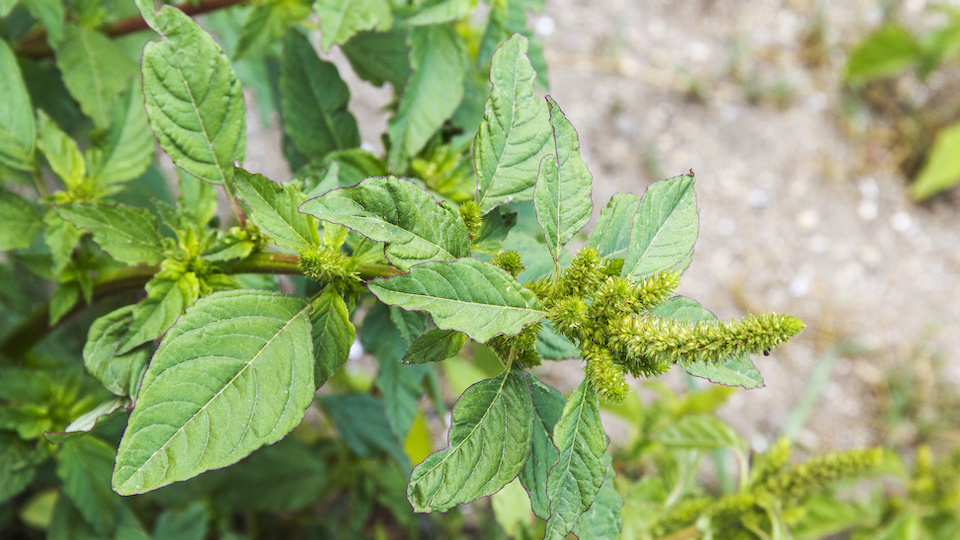If you live virtually anywhere in North America, you’ve likely heard of, and been irritated by pigweed. This green, unassuming weed has long been considered a severe nuisance since every single plant can produce nearly 100,000 seeds each season. If you’ve ever looked into healthy grain alternatives, you’ve probably come across something known as amaranth. A “super grain,” gluten-free, pseudocereal that is prized for its notable health benefits. Believe it or not, these two plants are actually one and the same. Read on as we delve into the truth behind pigweed and set the record straight once and for all.
Pigweed vs. Amaranth
Simply put, pigweed is the unofficial term for several wild species of the genus Amarantus. It is also called by various other names, including green amaranth, redroot amaranth, careless weed, tumbleweed, and callaloo. This particular plant is nothing special to look at, with dark green leaves, green flowers, and a tall stem. Note: if you are looking for a plant to add visual appeal to your garden, you may want to stay away from pigweed. Not just because it’s ugly, either, this plant can quickly spread and overwhelm your yard.
What is amaranth?
Each plant in the amaranth family, including pigweed, is totally edible and can be eaten as a leaf, seed, and vegetable. This group of plants has been a staple in many countries, including Central and Latin America and Asia since ancient times. The popular saying, “a weed is just a plant out of place,” is especially true when it comes to this divisive plant, as it is prized for its nutritional value in some countries and abhorred for its invasive nature in others.
The amaranth grain (which you can find on the shelves of most whole or natural food grocery stores) is loaded with beneficial nutrients and vitamins including potassium, zinc, Vitamin B and E. It is also a wonderful source of protein, even better than rice, sorghum, or rye, which makes it a great addition to a vegan diet. Remember, the type of amaranth grown for its seeds is quite different from pigweed, which is usually only harvested for its leaves.
What is pigweed?
Wild amaranth or pigweed is a little more weedy and leggy than its cultivated cousins. However, the leaves can be enjoyed, and they are high in vitamins A and C and folate, as well as calcium. It is incredibly hardy in North America and will thrive in a wide variety of climates, soil conditions, and moisture levels.
Pigweed is resistant to glyphosate, which makes it an enemy of many primary producers of herbicides, such as Monsanto (the manufacturers of Roundup). Throughout the years, this natural resistance and increasing perceived villainy has turned many away from the potential benefits of this underrated plant.
Health benefits of pigweed
As mentioned above, the much-detested weed known as pigweed is closely related to the highly praised pseudo-cereal amaranth. These seeds come from a relative of the pigweed plant and offer a number of extraordinary health benefits.
Contains antioxidants
Amaranth is loaded with antioxidants that can help eradicate harmful free radicals and decrease your risk of cancer and heart disease.
Could aid in weight loss
Since pigweed is loaded with fiber and protein, it may help keep you feeling full for longer and decrease the production of ghrelin, the hormone that stimulates hunger. Be sure to combine healthy foods such as pigweed with daily exercise for optimal benefit.
Reduce inflammation
Chronic inflammation can lead to a number of severe health concerns including cancer, diabetes, and autoimmune disorders. Amaranth and other anti-inflammatory foods work to reduce markers of inflammation in the body and restore it to normal levels.
How to enjoy pigweed
Though I wouldn’t recommend sticking pigweed in your garden, instead of throwing away these wild weeds, pull them up and bring them indoors to cook into a delicious side dish. Try the leaves stewed, sautéed, or toss them into a stir-fry with your favorite veggies and sauce. Pigweed leaves can also be added to an omelet for a delicious twist on a classic breakfast favorite. Avoid eating raw and wash thoroughly before cooking. Harvest the leaves when the plant is young for an optimal flavor that is often compared to spinach. The smaller leaves are also more nutrient rick and will be a lot more palatable than the larger ones.
When foraging for pigweed, be sure to stay away from areas that may have been sprayed with toxic herbicides. Since this plant is resistant to most weed-killers, the toxins will usually linger on the leaves if it has been sprayed, making it unsafe to eat. Stick to out of the way areas that are not near industrial farms.
As always, any time you forage for wild plants, your safety is your first priority. Do not trespass on private land, and be sure that you carefully identify what you are harvesting. Use all of your senses (except taste) and compare the plant you found to known pigweed you have enjoyed in the past before cooking it.
Have you ever eaten pigweed? What do you think of this plant? Let us know in the comments below!
-Susan Patterson



